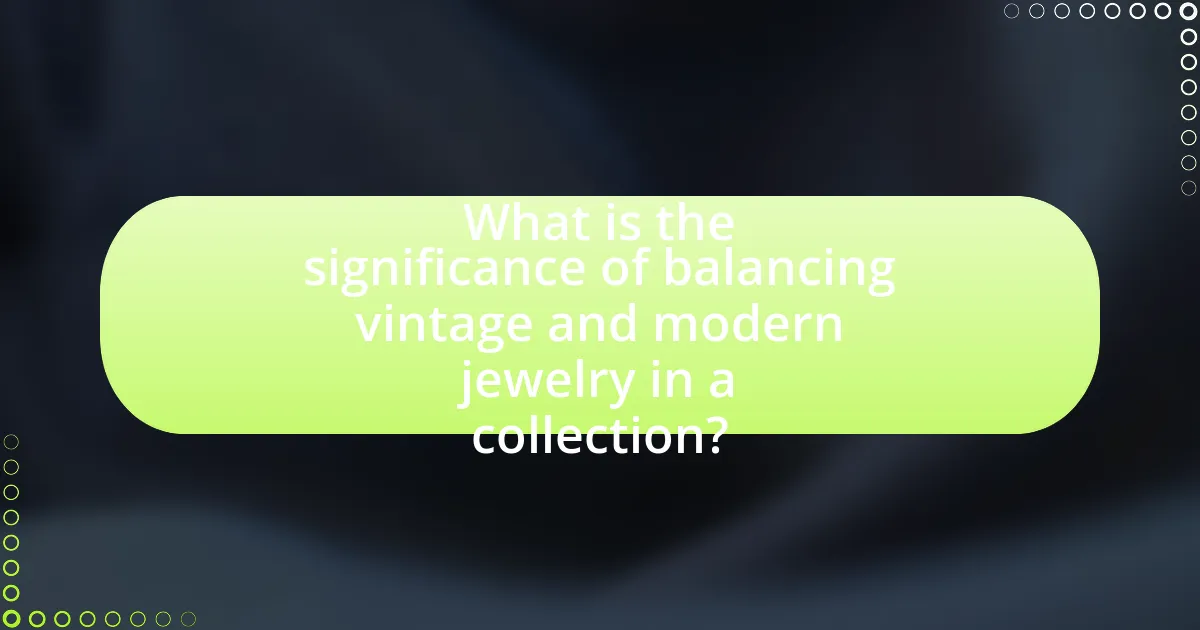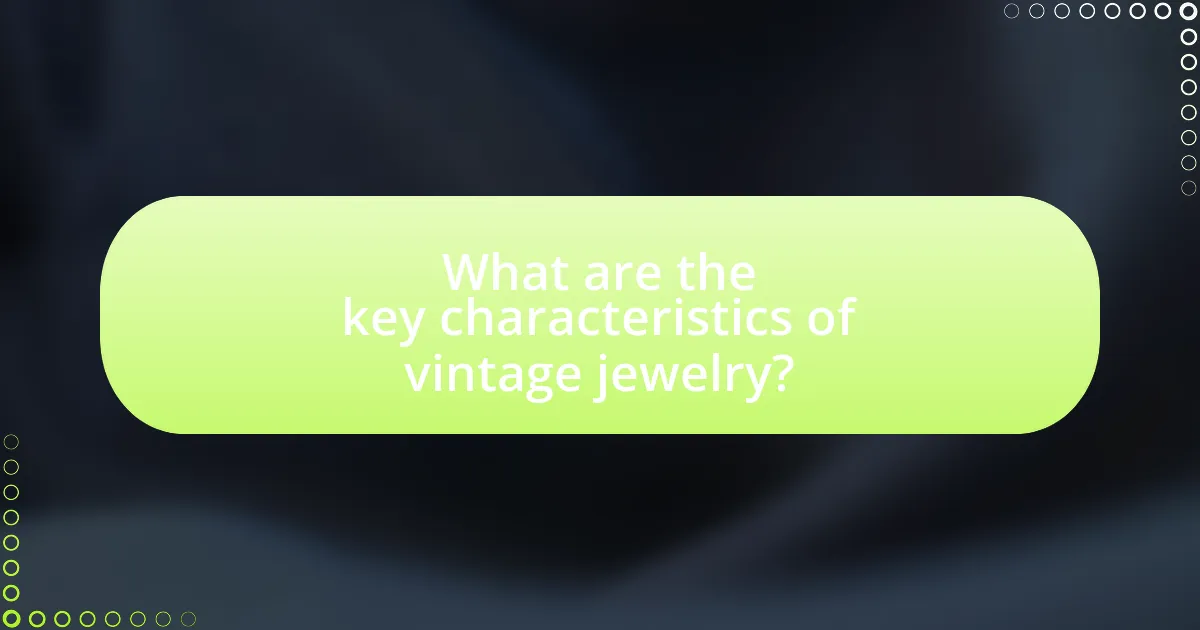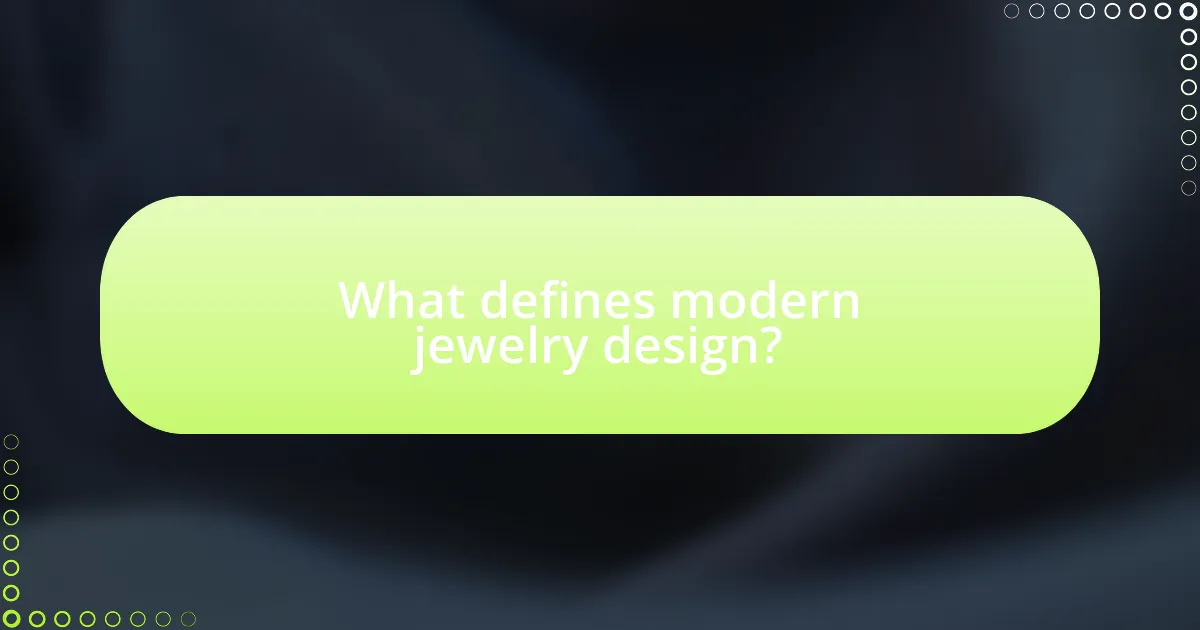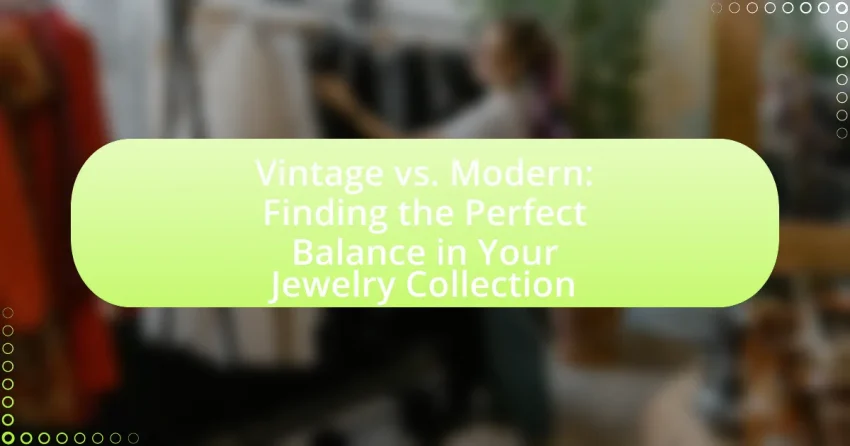The article “Vintage vs. Modern: Finding the Perfect Balance in Your Jewelry Collection” explores the significance of integrating both vintage and modern jewelry to create a diverse and valuable collection. It highlights the unique qualities of vintage pieces, such as historical significance and craftsmanship, alongside the contemporary appeal and innovative designs of modern jewelry. The article discusses factors influencing collectors’ choices, the emotional and investment value of vintage items, and strategies for effectively blending different styles. Additionally, it provides insights into curating a balanced collection that reflects personal style while appreciating in value over time.

What is the significance of balancing vintage and modern jewelry in a collection?
Balancing vintage and modern jewelry in a collection is significant because it creates a diverse aesthetic that appeals to a wider audience and enhances the overall value of the collection. Vintage pieces often carry historical significance and craftsmanship that can tell a story, while modern jewelry incorporates contemporary design trends and materials that resonate with current tastes. This combination allows collectors to showcase a range of styles, making the collection more versatile and interesting. Furthermore, according to a study by the Antique Jewelry University, vintage jewelry can appreciate in value over time, while modern pieces can attract buyers looking for fresh designs, thus ensuring a balanced investment strategy.
Why should collectors consider both vintage and modern pieces?
Collectors should consider both vintage and modern pieces to achieve a diverse and well-rounded jewelry collection. Vintage pieces often carry historical significance and unique craftsmanship, which can enhance the aesthetic and emotional value of a collection. For instance, vintage jewelry from the Art Deco period is renowned for its intricate designs and quality materials, making it highly sought after. On the other hand, modern pieces often incorporate contemporary design trends and innovative materials, appealing to current tastes and styles. By blending both vintage and modern items, collectors can create a collection that not only reflects personal style but also appreciates in value over time, as certain vintage pieces can increase significantly in worth due to rarity and demand.
What unique qualities do vintage pieces bring to a jewelry collection?
Vintage pieces bring distinct historical significance and craftsmanship to a jewelry collection. These items often reflect the design trends and cultural influences of their respective eras, making them unique in style and storytelling. For instance, vintage jewelry from the Art Deco period showcases geometric designs and intricate detailing that are not commonly found in modern pieces. Additionally, the materials used in vintage jewelry, such as older cuts of gemstones and unique metal alloys, contribute to their rarity and appeal. This combination of history, artistry, and rarity enhances the overall value and character of a jewelry collection.
How do modern designs enhance the overall aesthetic of a collection?
Modern designs enhance the overall aesthetic of a collection by introducing clean lines, innovative materials, and minimalist approaches that create a fresh and contemporary look. These elements contrast with vintage styles, allowing modern pieces to stand out while complementing traditional items. For instance, the use of geometric shapes and asymmetrical designs in modern jewelry can draw attention and create visual interest, making the entire collection more dynamic. Additionally, modern designs often incorporate sustainable materials and advanced manufacturing techniques, which not only appeal to eco-conscious consumers but also elevate the perceived value of the collection. This combination of aesthetics and functionality reinforces the collection’s appeal in today’s market.
What factors influence the choice between vintage and modern jewelry?
The choice between vintage and modern jewelry is influenced by personal style, emotional connection, and investment value. Personal style dictates preferences for design aesthetics, with vintage jewelry often reflecting historical trends and craftsmanship, while modern pieces may emphasize contemporary design and innovation. Emotional connection plays a significant role, as vintage jewelry can evoke nostalgia or family heritage, making it more meaningful to some individuals. Additionally, investment value is a crucial factor; vintage jewelry can appreciate over time due to rarity and historical significance, while modern jewelry may offer contemporary appeal but often lacks the same investment potential.
How does personal style impact the decision to choose vintage or modern pieces?
Personal style significantly influences the decision to choose vintage or modern pieces, as it reflects individual preferences, aesthetics, and values. For instance, individuals who favor a classic or nostalgic aesthetic may gravitate towards vintage jewelry, which often embodies unique craftsmanship and historical significance. Conversely, those who prioritize contemporary trends and minimalism are more likely to select modern pieces that align with current fashion standards. Research indicates that personal style is often shaped by cultural influences and personal experiences, further guiding choices in jewelry selection. This connection between personal style and jewelry choice underscores the importance of self-expression in fashion decisions.
What role does occasion play in selecting jewelry types?
Occasion significantly influences the selection of jewelry types, as different events call for specific styles and levels of formality. For instance, formal occasions such as weddings typically require elegant pieces like diamond earrings or pearl necklaces, while casual events may allow for more playful and trendy jewelry, such as beaded bracelets or minimalist rings. This distinction is supported by consumer behavior studies, which indicate that 70% of jewelry purchases are occasion-driven, highlighting the importance of context in decision-making.
How can collectors effectively integrate vintage and modern jewelry?
Collectors can effectively integrate vintage and modern jewelry by creating a cohesive aesthetic that highlights the unique characteristics of both styles. This can be achieved by selecting pieces that complement each other in terms of color, material, and design elements. For instance, pairing a vintage brooch with a modern necklace can create a striking contrast while maintaining harmony in the overall look.
Additionally, collectors should consider the historical context of vintage pieces and how they can enhance the narrative of modern designs. For example, a vintage Art Deco ring can serve as a conversation starter when worn alongside contemporary minimalist jewelry, showcasing the evolution of design trends.
Research indicates that blending different eras can enhance the visual appeal of a collection, as seen in fashion shows where designers often mix vintage and modern elements to create innovative looks. This approach not only enriches the collector’s personal style but also preserves the significance of vintage items while embracing contemporary trends.
What strategies can be used to create a cohesive look with mixed styles?
To create a cohesive look with mixed styles in jewelry, one effective strategy is to establish a unifying color palette. By selecting a few complementary colors that appear in both vintage and modern pieces, the overall collection can appear harmonious. For instance, if gold is a common element in both styles, incorporating gold accents in modern pieces can bridge the gap with vintage items. Additionally, maintaining a consistent material, such as using both vintage and modern pieces made from silver, can enhance cohesion. This approach is supported by design principles that emphasize color and material consistency as key factors in achieving visual unity across diverse styles.
How can layering techniques enhance the balance between vintage and modern pieces?
Layering techniques can enhance the balance between vintage and modern pieces by creating a cohesive visual narrative that harmonizes different styles. By strategically combining various textures, colors, and designs, individuals can showcase the unique characteristics of both vintage and modern jewelry, allowing each piece to complement rather than compete with one another. For instance, layering a delicate vintage necklace with a bold modern statement piece can draw attention to the intricacies of the vintage design while grounding it with contemporary flair. This approach not only highlights the contrast between eras but also fosters a personalized aesthetic that reflects individual style, making the overall look more dynamic and engaging.

What are the key characteristics of vintage jewelry?
Vintage jewelry is characterized by its unique craftsmanship, historical significance, and distinctive design elements that reflect the era in which it was made. Typically, vintage jewelry refers to pieces that are at least 20 to 100 years old, showcasing materials and techniques that were prevalent during their time of creation. For example, Art Deco jewelry from the 1920s features geometric shapes and bold colors, while Victorian pieces often incorporate intricate detailing and romantic motifs. The use of high-quality materials, such as gold, silver, and genuine gemstones, further distinguishes vintage jewelry from modern mass-produced items. Additionally, vintage jewelry often carries a sense of nostalgia and cultural heritage, making it highly sought after by collectors and enthusiasts.
How can one identify authentic vintage jewelry?
To identify authentic vintage jewelry, examine the piece for specific characteristics such as craftsmanship, materials, and hallmarks. Authentic vintage jewelry typically features high-quality materials like gold, silver, or genuine gemstones, and displays intricate craftsmanship that reflects the era it was made in, often with unique design elements that are not common in modern pieces. Additionally, look for hallmarks or stamps that indicate the manufacturer, metal purity, or country of origin, as these can provide valuable information about the jewelry’s authenticity and age. For example, pieces made before 1950 often have specific marks that can be cross-referenced with jewelry databases or guides to confirm their vintage status.
What are the common hallmarks and features of vintage pieces?
Common hallmarks and features of vintage pieces include unique craftsmanship, distinctive materials, and specific design elements that reflect the era of their creation. Vintage jewelry often showcases intricate detailing, such as filigree work or hand-set stones, which are less common in modern mass-produced items. Additionally, vintage pieces may feature specific marks or stamps indicating their origin, maker, or metal content, such as the 14K or 18K gold stamps prevalent in older jewelry. These characteristics not only signify the age of the piece but also its historical and cultural significance, making vintage jewelry highly sought after by collectors and enthusiasts.
How does the era of a vintage piece affect its value and appeal?
The era of a vintage piece significantly influences its value and appeal due to historical context, craftsmanship, and rarity. Vintage items from specific periods, such as Art Deco or Victorian, often carry a premium because they reflect unique design trends and techniques of their time. For example, Art Deco jewelry, characterized by geometric shapes and bold colors, is highly sought after, leading to higher market values. Additionally, the scarcity of pieces from certain eras enhances their desirability; for instance, jewelry made during World War II is limited due to production constraints, making it more valuable. Collectors and enthusiasts often seek pieces that represent a particular era, further driving demand and appreciation for vintage items.
What are the benefits of investing in vintage jewelry?
Investing in vintage jewelry offers several benefits, including potential appreciation in value, unique craftsmanship, and historical significance. Vintage jewelry often appreciates over time due to its rarity and the increasing demand for unique pieces, with some items appreciating by as much as 20% annually. The craftsmanship of vintage jewelry is typically superior, as many pieces were handmade with high-quality materials, making them more durable and distinctive compared to mass-produced modern jewelry. Additionally, vintage pieces carry historical significance, often reflecting the cultural and artistic movements of their time, which can enhance their appeal to collectors and investors alike.
How does vintage jewelry appreciate in value over time?
Vintage jewelry appreciates in value over time primarily due to its rarity, historical significance, and craftsmanship. As demand for unique and authentic pieces increases, collectors and investors often seek vintage items, driving up their market value. For instance, a study by the Antique Jewelry University indicates that certain vintage pieces can appreciate by 20% to 30% annually, particularly those from renowned designers or specific eras, such as Art Deco or Victorian. Additionally, the limited supply of vintage jewelry, combined with its cultural and aesthetic appeal, further enhances its desirability and value over time.
What emotional and historical significance do vintage pieces hold?
Vintage pieces hold significant emotional and historical value as they often embody personal stories, cultural heritage, and craftsmanship from specific eras. These items can evoke nostalgia and connection to past generations, making them cherished possessions for individuals and families. Historically, vintage jewelry reflects the artistic styles and societal values of its time, providing insight into fashion trends, technological advancements, and social changes. For example, Art Deco pieces from the 1920s showcase geometric designs and luxury materials, representing a period of economic prosperity and cultural innovation. Thus, vintage pieces serve as tangible links to history and personal memories, enriching their emotional significance.

What defines modern jewelry design?
Modern jewelry design is characterized by innovative materials, minimalist aesthetics, and a focus on individuality. This approach often incorporates unconventional elements such as mixed metals, synthetic stones, and sustainable practices, reflecting contemporary values and technological advancements. For instance, the use of 3D printing in jewelry creation allows for intricate designs that were previously unattainable, showcasing the blend of art and technology in modern craftsmanship. Additionally, modern jewelry often emphasizes personal expression, moving away from traditional forms and embracing unique, bespoke pieces that resonate with the wearer’s identity.
How do contemporary trends influence modern jewelry styles?
Contemporary trends significantly influence modern jewelry styles by promoting minimalism, sustainability, and personalization. Minimalism is evident in the rise of sleek, simple designs that prioritize clean lines and understated elegance, reflecting a broader cultural shift towards simplicity in lifestyle choices. Sustainability has become a critical factor, with many modern jewelers using ethically sourced materials and eco-friendly practices, responding to consumer demand for responsible production. Personalization is also a key trend, as consumers increasingly seek unique pieces that reflect their individual identities, leading to the popularity of custom designs and bespoke jewelry. These trends collectively shape the aesthetics and values of modern jewelry, aligning them with current societal preferences and ethical considerations.
What materials and techniques are commonly used in modern jewelry?
Modern jewelry commonly utilizes materials such as gold, silver, platinum, and alternative metals like titanium and stainless steel, along with gemstones, pearls, and synthetic materials. Techniques frequently employed include casting, soldering, stone setting, and 3D printing. The use of gold and silver is prevalent due to their malleability and aesthetic appeal, while platinum is favored for its durability. Gemstones and pearls add color and elegance, and synthetic materials allow for innovative designs. The adoption of 3D printing has revolutionized the industry by enabling intricate designs that were previously difficult to achieve, showcasing the blend of traditional craftsmanship with modern technology.
How does modern jewelry reflect current cultural and fashion trends?
Modern jewelry reflects current cultural and fashion trends by incorporating minimalist designs, sustainable materials, and personalization. These elements resonate with contemporary values such as environmental consciousness and individual expression. For instance, the rise of ethical jewelry brands, which prioritize recycled metals and conflict-free gemstones, aligns with the growing consumer demand for sustainability, as evidenced by a 2021 survey indicating that 66% of global consumers are willing to pay more for sustainable brands. Additionally, the trend towards customization allows consumers to create unique pieces that reflect their personal stories, further emphasizing the shift towards individuality in fashion.
What advantages does modern jewelry offer to collectors?
Modern jewelry offers collectors the advantage of innovative design and contemporary materials, which often result in unique pieces that reflect current trends and artistic expressions. This innovation allows collectors to acquire items that are not only aesthetically pleasing but also often incorporate advanced techniques such as 3D printing and sustainable practices. Additionally, modern jewelry frequently features a wider range of customization options, enabling collectors to personalize their pieces to a greater extent than vintage options typically allow. The growing market for modern jewelry also means that collectors can benefit from increased availability and accessibility, as many contemporary designers actively engage with their audience through online platforms and social media, enhancing the buying experience.
How does modern jewelry cater to diverse tastes and preferences?
Modern jewelry caters to diverse tastes and preferences by offering a wide range of styles, materials, and customization options. This inclusivity allows consumers to find pieces that resonate with their individual aesthetics, whether they prefer minimalist designs, bold statement pieces, or culturally inspired motifs. For instance, the rise of sustainable materials and ethical sourcing has attracted environmentally conscious buyers, while the availability of personalized jewelry, such as engraved items or bespoke designs, appeals to those seeking unique expressions of identity. Additionally, the influence of global fashion trends ensures that modern jewelry reflects a variety of cultural influences, further broadening its appeal.
What innovations in design and technology enhance modern jewelry?
Innovations in design and technology that enhance modern jewelry include 3D printing, computer-aided design (CAD), and the use of sustainable materials. 3D printing allows for intricate designs that were previously impossible to create by hand, enabling jewelers to produce unique pieces with precision. CAD software facilitates the design process, allowing for detailed visualizations and modifications before production, which streamlines the creation of complex jewelry designs. Additionally, the incorporation of sustainable materials, such as lab-grown diamonds and recycled metals, reflects a growing consumer demand for environmentally responsible practices in the jewelry industry. These advancements not only improve the aesthetic and functional aspects of jewelry but also align with contemporary values regarding sustainability and innovation.
What are the best practices for curating a balanced jewelry collection?
To curate a balanced jewelry collection, focus on diversity in styles, materials, and eras. Incorporating a mix of vintage and modern pieces ensures that the collection appeals to various tastes and occasions. For instance, vintage jewelry often features unique craftsmanship and historical significance, while modern pieces can offer contemporary designs and innovative materials. Aim for a balance by selecting items that complement each other, such as pairing classic pearl earrings with a modern geometric necklace. Additionally, consider the versatility of each piece; items that can be worn in multiple settings enhance the overall utility of the collection. Research indicates that a well-rounded collection not only reflects personal style but also increases the potential for appreciation in value over time, particularly when it includes sought-after vintage items.
How can collectors assess their current collection for balance?
Collectors can assess their current collection for balance by evaluating the variety and proportion of vintage and modern pieces. This involves categorizing items based on their era, style, and material, then analyzing the representation of each category within the collection. For instance, if a collection contains 70% vintage jewelry and only 30% modern pieces, it may indicate an imbalance favoring vintage styles. Collectors can also consider the aesthetic harmony and functionality of the pieces, ensuring that they complement each other in terms of design and wearability. Additionally, reviewing market trends and personal preferences can provide insight into whether the collection aligns with current tastes and values, further guiding adjustments for balance.
What tips can help in sourcing both vintage and modern pieces effectively?
To source both vintage and modern pieces effectively, prioritize establishing a clear understanding of your desired style and budget. Research reputable sources such as antique shops, estate sales, and online marketplaces like Etsy or eBay for vintage items, while exploring contemporary jewelry designers and boutiques for modern pieces. Utilize social media platforms to follow trends and connect with sellers. According to a study by the Antique Jewelry University, vintage jewelry often appreciates in value, making it a worthwhile investment when sourced correctly.
